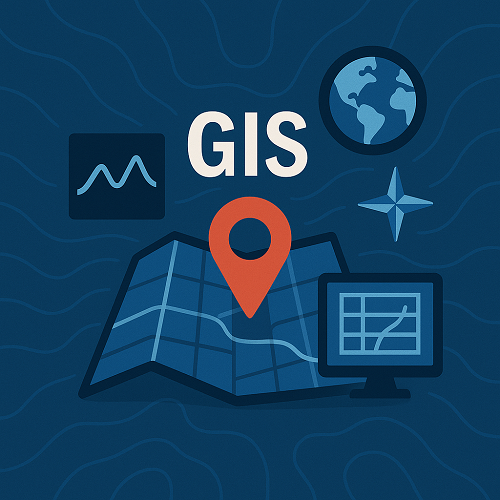TL;DR
- AI-powered GIS solutions are revolutionizing spatial analysis and predictive modeling.
- Real-time data integration supports smarter urban and environmental planning.
- Blockchain enhances trust and traceability across geospatial data chains.
- Open data initiatives accelerate interoperability and innovation in GIS ecosystems.
- Businesses gain competitive edge through intelligent location-based insights.
What’s New Right Now
In 2025, the Geospatial Information System (GIS) landscape is transforming through the fusion of artificial intelligence (AI), automation, and distributed ledger technologies. Leading providers are deploying AI models for advanced spatial analytics, enabling applications from precision agriculture to smart infrastructure. Meanwhile, blockchain frameworks are emerging to secure and authenticate spatial datasets, ensuring reliability for governments and enterprises. The global trend toward open geospatial data standards continues to drive interoperability and transparency across platforms. As confirmed by ongoing industry reviews at Geospatial World, these changes set the stage for a more collaborative and automated GIS future.
Why It Matters
For technical leaders, modern GIS tools turn massive spatial datasets into actionable intelligence. AI-driven geospatial processing reduces manual effort and speeds up complex modeling tasks such as land-use forecasting or disaster risk prediction. Business stakeholders benefit from improved decision support systems, helping optimize operations, logistics, and resource allocation. In 2025, GIS is not only a mapping tool—it’s a strategic intelligence framework for sustainable development and competitive advantage.
Major Trends Reshaping GIS
1. AI Integration and Advanced Analytics
Machine learning and neural networks are redefining GIS workflows. Algorithms can now detect spatial patterns, predict urban expansion, and assist in climate impact assessment with high accuracy. Tools leveraging AI-insights enable planners to simulate future scenarios and optimize land and infrastructure use.
2. Real-Time Data Processing
Real-time spatial analytics leveraging IoT sensors, drones, and satellite streams are now a core component of GIS operations. This immediacy supports emergency response, traffic management, and environmental monitoring, offering near-instant situational awareness for decision-makers.
3. Blockchain for Data Provenance
Blockchain is emerging as a verifiable ledger for spatial data, ensuring the integrity of datasets exchanged between agencies or private firms. By assigning digital signatures to geospatial records, stakeholders can track data ownership and authenticity, critical for infrastructure planning and public trust.
4. Open and Interoperable GIS Platforms
Open data and interoperability initiatives by groups such as the Esri community and international partners support a more connected GIS ecosystem. This democratizes access and supports innovation across sectors through shared, standardized datasets.
| Approach | Key Strength | Typical Use Case |
|---|---|---|
| Traditional GIS | Stable, well-documented workflows | Cartography, static data analysis |
| AI-Enhanced GIS | Predictive and automated insights | Urban growth prediction, risk modeling |
| Real-Time GIS | Continuous data feedback | Disaster management, smart traffic control |
| Blockchain-based GIS | Data integrity and provenance | Land registry, cross-agency data exchange |
Mini Case Study: Smart Flood Resilience in Coastal Asia
Problem: A Southeast Asian city was facing recurrent flooding, with insufficient predictive tools to guide mitigation strategies.
Approach: The municipality deployed an AI-integrated GIS solution connected to IoT-based flood sensors. Real-time rainfall and tidal data fed into a machine learning model that forecasted flood-prone zones hours ahead of peak rainfall periods. Blockchain was adopted to secure observational data across multiple municipal departments.
Outcome: Within a single monsoon season, the city reduced critical-response times by 30%. Infrastructure repair costs dropped by 15%, and predictive alerts reached 95% accuracy, improving community resilience and urban mobility.
Implementation Checklist
- Assess data sources for completeness, quality, and interoperability potential.
- Select a GIS platform compatible with AI and real-time data integrations.
- Adopt open data standards (e.g., OGC-compliant schemas) to ensure portability.
- Integrate machine learning frameworks for predictive spatial analytics.
- Use blockchain or digital signatures for secure data lineage tracking.
- Train staff in spatial data science and automated workflow optimization.
- Regularly evaluate system performance and compliance with data policies.
FAQs
What is AI-driven GIS?
AI-driven GIS combines geospatial datasets with machine learning algorithms to uncover trends, predict outcomes, and automate analysis workflows.
How does blockchain add value to GIS data?
Blockchain provides immutable records and verifies transaction authenticity, ensuring GIS datasets remain tamper-proof and trustworthy.
What are the benefits of open geospatial data?
Open geospatial data supports innovation by allowing developers and researchers to collaborate, share findings, and create interoperable solutions.
Is real-time GIS only for large organizations?
No. Cloud-based and open-source solutions make real-time GIS accessible to small municipalities, NGOs, and startups alike.
How does GIS support sustainability?
GIS helps map and monitor environmental variables, supporting informed decision-making on resource management, conservation, and climate adaptation.
What skills are in demand for modern GIS professionals?
Data analytics, programming (Python, R), cloud integration, and AI modeling are key competencies for 2025 GIS practitioners.
Conclusion
GIS technology in 2025 has transcended its traditional role, becoming an intelligent infrastructure that fuses AI, blockchain, and real-time insight into spatial decision-making. From climate resilience to supply chain optimization, the opportunities are extensive. To harness these innovations for your organization’s growth and sustainability goals, explore our GIS services and discover how advanced geospatial intelligence can transform your strategy.
